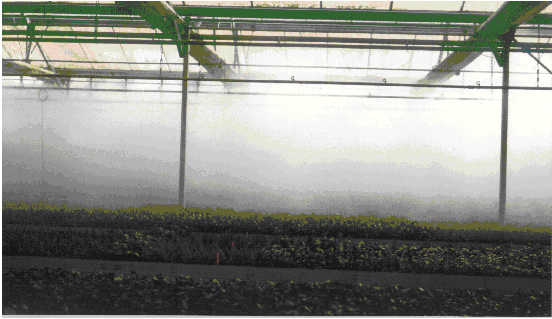 |
Innovative Tools
Fog Control
Humidity Control in propagation chambers
The humidity control on the plant propagation chambers is one of most difficult control problems for an agricultural engineering. The humidity on those chambers must be kept in very high levels (around 95%). The problem is that we must avoid the concentration of water drips on the surface of the plant leafs, the desired is to achieve only a thin film of water covering the surface leafs and to add more water when this film is evaporated.
To control the humidity we use the fog system that a propagation chamber must be equipped. The most common technique is to spray on fixed time periods, with this technique the problem is that we spray in fixed periods without feedback from the situation in the chamber. The result is that when the solar radiation is high we are not spraying enough and the humidity is kept low and when the solar radiation is low we are over spraying and the leafs are kept always in wet conditions. The use of the humidity sensor for the control of the fog system was failed. The humidity sensor was working well for less than 3 weeks and after this period a replacement was needed or recalibration of the sensor. The very high humidity levels in high duration were destroying the sensor calibration and more often the sensor it self (the sensors were the most expensive sensors founded in the market).
To solve this problem the “Electronic Leaf Sensor” method was implemented at the propagation chamber on Papanikolaoy nurseries. The method of the electronic leaf sensor was implemented in order to achieve the desired climate conditions regardless the outside conditions. With this method a model based on standard climate measurements that their sensors are not affected by the high humidity conditions (Temperature, Solar radiation) is used to calculate and adjust automatically the spraying period. This model calculates the evaporation of the water from the leafs and when the water is consumed then the fog system is operating again. The model is of the form:
E = a * Solar Radiation + b * Temperature.
The parameters a and b they are calculated by the desired minimum and maximum time period of the spraying under high and low evaporation conditions respectively. The integration of E is compared with a fixed number Eo representing the water that the fog system adds to the chamber and when E >= Eo then the fog system operates.
 |
The propagation chamber in Papanikolaoy nurseries with the spraying system in operation